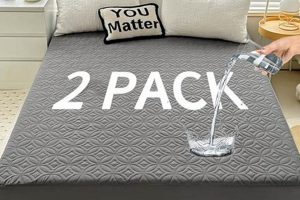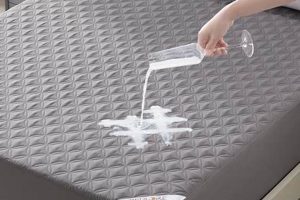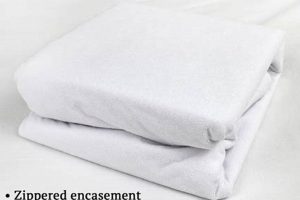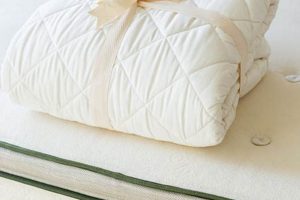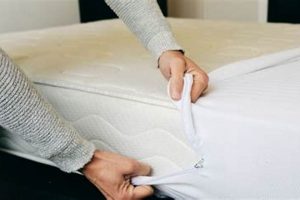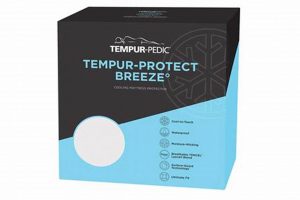A barrier designed to shield a sleeping surface from liquid damage, particularly from bodily fluids, is a crucial element in maintaining hygiene and prolonging the lifespan of bedding. These specialized covers provide a robust layer of defense against accidental spills and incontinence, preventing moisture from penetrating the mattress core. For example, individuals with young children, elderly family members, or those managing specific medical conditions find these protective measures invaluable.
The implementation of such a shield offers significant advantages. By preventing liquids from reaching the mattress, it inhibits the growth of mold, mildew, and bacteria, contributing to a healthier sleep environment. This protection also preserves the integrity of the mattress, preventing staining, odors, and structural damage that can lead to premature replacement. Historically, simpler versions like rubber sheets were used; however, modern iterations often incorporate breathable, waterproof membranes for enhanced comfort.
The subsequent sections will detail the construction materials, different types available, considerations for choosing an appropriate option, and proper care and maintenance procedures to maximize effectiveness and longevity.
Optimizing Protection
Selecting and maintaining an appropriate barrier is essential for ensuring the effective safeguarding of bedding against liquid intrusion. The following points offer guidance on maximizing the performance and lifespan of such protective measures.
Tip 1: Material Selection: Evaluate the composition of the protective layer. Polyurethane and TPU (Thermoplastic Polyurethane) offer robust waterproof capabilities while remaining breathable. Consider the balance between protection and comfort when choosing materials.
Tip 2: Fit and Securement: Ensure the chosen size corresponds precisely to the dimensions of the mattress. Fitted styles with elasticized edges offer a secure fit, preventing slippage and maintaining comprehensive coverage. Regularly inspect the fit to guarantee ongoing protection.
Tip 3: Breathability Considerations: While waterproofness is paramount, breathability minimizes moisture buildup and promotes airflow, preventing discomfort and reducing the risk of mold growth. Seek options with breathable membranes or specialized fabric constructions.
Tip 4: Proper Installation: Adhere to the manufacturer’s instructions during installation. Ensure the entire mattress surface is adequately covered, paying close attention to corners and edges. Smooth out any wrinkles or creases to maintain an even protective layer.
Tip 5: Regular Cleaning: Follow the manufacturer’s recommended cleaning protocols. Promptly address spills or accidents by blotting up excess liquid and laundering the protector as needed. This prevents staining, odor buildup, and potential damage to the protective membrane.
Tip 6: Layered Protection: For enhanced security, particularly in situations involving heavy incontinence, consider utilizing multiple layers of protection. A combination of a mattress encasement and a removable protector can provide a more robust defense.
Tip 7: Regular Inspection and Replacement: Periodically inspect the protector for signs of wear and tear, such as cracks, tears, or delamination. Replace the protector as needed to maintain optimal performance. A proactive approach ensures continuous safeguarding of the mattress.
Adherence to these guidelines helps maintain the integrity of the mattress, promoting a clean and healthy sleep environment while extending the life of the bedding investment.
The concluding section will summarize the advantages and offer final recommendations for long-term bed protection.
1. Waterproof Barrier
A “urine proof mattress protector” fundamentally relies on the presence of a reliable waterproof barrier. This feature is not merely an addition, but rather a core component that defines the product’s functionality. The primary function of a mattress protector designed for urine protection is to prevent liquids from penetrating the underlying mattress. The waterproof barrier achieves this by creating an impermeable layer that intercepts fluids, preventing them from soaking into the absorbent mattress fibers. Failure of this barrier renders the entire product ineffective.
For example, in situations involving infant bedwetting or adult incontinence, the waterproof barrier serves as the last line of defense against permanent mattress damage. Without it, urine seeps into the mattress, leading to staining, unpleasant odors, and the proliferation of bacteria and mold. The presence of a functional barrier negates these issues. Further, the waterproof nature of the barrier often extends the usability of the mattress by preventing the need for frequent and costly professional cleaning or premature replacement.
In summary, the waterproof barrier is inextricably linked to the purpose of a “urine proof mattress protector.” Its integrity directly correlates with the protector’s ability to perform its intended function, safeguarding the mattress from irreversible damage caused by liquid exposure. The effectiveness and durability of the protector are therefore contingent upon the quality and construction of this crucial waterproof layer.
2. Breathable Membrane
The integration of a breathable membrane within a “urine proof mattress protector” represents a critical advancement in balancing impermeable liquid protection with user comfort and long-term hygiene. The membrane’s functionality significantly impacts the overall effectiveness and desirability of the protective bedding layer.
- Moisture Vapor Permeability
The primary role of a breathable membrane is to permit the passage of water vapor while simultaneously blocking liquid water. This selective permeability allows perspiration and body heat to dissipate, preventing the buildup of moisture within the sleeping environment. Without this breathability, the protector would trap heat and moisture, leading to discomfort and potentially fostering microbial growth. For example, membranes constructed from microporous materials like polyurethane allow microscopic water vapor molecules to escape, maintaining a drier sleep surface.
- Reduction of Condensation
By facilitating moisture vapor transfer, the breathable membrane minimizes condensation formation on the mattress surface. Condensation can create a damp environment conducive to mold and mildew proliferation. This is especially crucial in prolonged contact situations, such as overnight use. A breathable membrane, therefore, contributes to long-term mattress hygiene and reduces allergenic potential.
- Enhanced Comfort
The breathability attribute directly impacts user comfort. Non-breathable protectors, such as those made solely from vinyl, can generate a sticky and uncomfortable sleep surface. A breathable membrane, on the other hand, promotes airflow, reducing heat retention and enhancing overall sleep quality. For example, individuals with sensitive skin or those prone to night sweats benefit significantly from the added comfort afforded by a breathable membrane.
- Material Durability and Longevity
Breathable membranes often enhance the overall durability of the “urine proof mattress protector”. By allowing moisture to escape, the membrane prevents the breakdown of adhesives and internal materials within the protector caused by prolonged dampness. The enhanced longevity of the protector thus results in a more cost-effective and sustainable solution over time.
The characteristics of the breathable membrane within a “urine proof mattress protector” are integral to its performance. The ability to balance waterproof protection with the promotion of air circulation directly influences comfort, hygiene, and the long-term preservation of both the protector and the underlying mattress.
3. Fitted Design
The implementation of a fitted design in “urine proof mattress protectors” is not merely aesthetic; it represents a functional imperative that directly influences the protector’s performance and effectiveness in safeguarding the underlying mattress. This design element addresses practical considerations concerning coverage, security, and ease of use, all critical to the protector’s intended purpose.
- Secure Encasement
A fitted design, typically incorporating elasticized edges, ensures a snug and secure fit over the mattress. This prevents slippage and shifting, maintaining consistent coverage across the entire sleep surface. In the event of liquid spillage or incontinence, this secure fit is crucial in preventing fluids from circumventing the protector and reaching the mattress. For example, a fitted protector is less likely to bunch or wrinkle during sleep, thereby minimizing gaps that could compromise its protective capabilities.
- Comprehensive Coverage
The fitted design allows for full and consistent protection, extending to the mattress sides and, in some cases, partially under the mattress corners. This comprehensive approach minimizes the risk of liquids seeping into vulnerable areas, such as the seams or edges of the mattress. This is particularly important as these areas often lack the inherent resistance to moisture exhibited by the mattress’s primary surface. Consistent coverage eliminates potential weak points in the overall protective barrier.
- Ease of Application and Removal
Fitted designs facilitate straightforward installation and removal, simplifying the process of laundering or replacement. The elasticized edges allow the protector to be quickly and easily stretched over the mattress, securing it in place without requiring specialized tools or techniques. This user-friendly design encourages regular cleaning and maintenance, essential for preserving the protector’s hygiene and prolonging its lifespan. Difficulty in removing or installing a protector can lead to infrequent cleaning, increasing the risk of bacterial growth and odor retention.
- Compatibility with Mattress Depths
Fitted mattress protectors are typically available in a range of depths to accommodate various mattress thicknesses. Selecting a protector with an appropriate depth ensures a secure and wrinkle-free fit, maximizing its protective capabilities. An ill-fitting protector, either too shallow or too deep, is more prone to slippage and compromise, reducing its effectiveness in preventing liquid penetration. Proper sizing is, therefore, crucial for achieving optimal performance.
The integration of a fitted design is not an optional feature but a fundamental component of a “urine proof mattress protector.” The secure encasement, comprehensive coverage, ease of use, and compatibility with varying mattress depths collectively contribute to the protector’s overall effectiveness in safeguarding the mattress and promoting a hygienic sleep environment.
4. Hypoallergenic
The term “hypoallergenic,” when applied to a “urine proof mattress protector,” denotes a design and material composition intended to minimize the potential for allergic reactions. This characteristic is particularly relevant given the close proximity of the mattress protector to the sleeper and the potential for allergen accumulation over time.
- Dust Mite Barrier
Hypoallergenic mattress protectors often feature tightly woven fabrics or specialized membranes that act as a barrier against dust mites and their associated allergens. Dust mites thrive in bedding and are a common trigger for allergies and asthma. By preventing dust mite penetration, the protector reduces allergen exposure. For example, protectors with a pore size of less than 10 microns can effectively block dust mites. This feature is especially crucial for individuals with pre-existing respiratory conditions or sensitivities.
- Material Composition
Hypoallergenic protectors are typically constructed from materials known for their low allergenic potential. Common examples include organic cotton, bamboo, and synthetic fibers like polyester and nylon. These materials are less likely to harbor allergens or release volatile organic compounds (VOCs) that can irritate sensitive individuals. In contrast, protectors made from treated fabrics or those containing natural latex may pose a higher risk of allergic reactions in susceptible individuals.
- Inhibition of Mold and Bacteria Growth
The waterproof properties of a “urine proof mattress protector” inherently contribute to a hypoallergenic environment by preventing the accumulation of moisture, which can promote mold and bacteria growth. Mold spores and bacterial byproducts are potent allergens that can exacerbate respiratory issues and skin sensitivities. By maintaining a dry and clean sleep surface, the protector minimizes the proliferation of these allergens. For example, some protectors incorporate antimicrobial treatments to further inhibit microbial growth.
- Easy Cleaning and Maintenance
Hypoallergenic mattress protectors are typically designed for easy cleaning and maintenance, allowing for the regular removal of accumulated allergens. Machine washability and dryer-safe properties facilitate frequent laundering, ensuring a consistently clean and allergen-free sleep environment. The ability to easily remove and wash the protector reduces the overall allergen load in the bedding, contributing to improved respiratory health and reduced allergic symptoms. For example, washing the protector in hot water (above 130F or 54C) can effectively kill dust mites and remove allergens.
The integration of hypoallergenic features in a “urine proof mattress protector” provides a comprehensive approach to allergen control, safeguarding the sleep environment and promoting the well-being of individuals with sensitivities or allergies. These combined features enhance both the protective and health-related aspects of the mattress protector.
5. Easy Cleaning
The attribute of “easy cleaning” is an essential and non-negotiable characteristic of a functional “urine proof mattress protector.” The effectiveness of such a protector is directly contingent upon its ability to be readily cleaned and sanitized following incidents of urine exposure. Urine, if not promptly and thoroughly removed, can lead to persistent odors, bacterial growth, and irreversible staining of the underlying mattress. Therefore, the ease with which the protector can be cleaned is paramount in maintaining hygiene, preventing long-term damage, and ensuring the continued effectiveness of the protective barrier. For example, a protector requiring specialized cleaning agents or complex procedures would be significantly less practical and less likely to be cleaned regularly, thereby negating its primary function.
The practical significance of “easy cleaning” extends beyond mere convenience. Regular and effective cleaning prevents the accumulation of urine residue, which can degrade the waterproof membrane over time, compromising its protective capabilities. Protectors designed for machine washing and drying at appropriate temperatures ensure thorough sanitization, eliminating odor-causing bacteria and preventing the development of mold or mildew. The ability to quickly launder and dry the protector minimizes downtime, allowing for prompt restoration of the protected sleep surface. An example of this would be a protector designed to be washed on a hot water cycle with bleach to eliminate persistent odors; this feature would greatly benefit families with young children that are not fully potty trained.
In conclusion, “easy cleaning” is intrinsically linked to the performance and longevity of a “urine proof mattress protector.” It is not a secondary consideration but a fundamental requirement for maintaining hygiene, preventing mattress damage, and ensuring the protector continues to fulfill its intended purpose of safeguarding the sleep environment. The absence of this attribute significantly diminishes the value and effectiveness of the protective bedding layer, ultimately failing to adequately address the challenges associated with urine exposure. Further, an easily cleaned and maintained “urine proof mattress protector” protects the user and the investment in the bedding.
6. Durability
The concept of durability is paramount when evaluating a “urine proof mattress protector,” representing a crucial determinant of its long-term value and effectiveness. The primary function of such a protector is to shield the mattress from fluid damage, a role that necessitates resistance to wear, tear, and degradation over sustained use. A protector lacking durability will inevitably fail, compromising its protective capabilities and leading to costly mattress damage and replacement. Consider a scenario where a protector’s waterproof membrane delaminates after only a few wash cycles; the compromised barrier leaves the mattress vulnerable, rendering the product functionally useless despite its initial claims.
The durability of a “urine proof mattress protector” is directly influenced by the quality of its constituent materials and its construction. Strong, tightly woven fabrics provide resistance to abrasion and puncture, while robust waterproof membranes, such as TPU (Thermoplastic Polyurethane), offer superior protection against liquid penetration and chemical degradation from urine. Reinforced seams and elasticized edges further enhance the protector’s ability to withstand repeated washing and stretching. A protector with double-stitched seams, for example, will prove more resistant to tearing and separation compared to one with single-stitched seams, ensuring long-term structural integrity. The implications of this can be profound; a more durable protector requires less frequent replacement, leading to cost savings and reduced environmental impact.
In summary, durability is not merely an ancillary feature but a fundamental requirement for a “urine proof mattress protector” to effectively fulfill its intended purpose. A durable protector provides sustained protection against fluid damage, resists wear and tear from repeated washing, and ultimately offers long-term value and peace of mind. Prioritizing durability ensures the protector will safeguard the mattress investment for years to come, making it a wise and cost-effective choice. Failing to adequately account for the durability of a urine proof mattress protector risks not only compromising the hygiene and lifespan of the mattress, but also wasting the investment in a product that fails to deliver long-term performance.
Frequently Asked Questions
The following questions address common concerns and misconceptions regarding the selection, use, and maintenance of mattress protectors designed to prevent urine damage.
Question 1: How does a urine proof mattress protector differ from a standard mattress protector?
A urine proof mattress protector incorporates a specialized waterproof membrane that prevents liquids from penetrating the mattress. Standard mattress protectors may offer some level of protection against spills, but typically lack the impermeable barrier necessary to safeguard against urine and other bodily fluids.
Question 2: What materials are most effective for a urine proof mattress protector?
Effective materials include polyurethane (PU) and thermoplastic polyurethane (TPU) for the waterproof membrane. These materials offer a balance of waterproofness and breathability. The top layer fabric often consists of cotton, polyester, or bamboo, chosen for comfort and absorbency.
Question 3: How often should a urine proof mattress protector be cleaned?
A urine proof mattress protector should be cleaned immediately after any urine exposure. For general hygiene, it should also be laundered every 1-2 months, or more frequently if needed. Refer to the manufacturer’s instructions for specific cleaning recommendations.
Question 4: Will a urine proof mattress protector affect the breathability of the mattress?
While some reduction in breathability may occur, quality urine proof mattress protectors utilize breathable membranes to minimize heat buildup and moisture retention. Look for protectors specifically marketed as breathable to mitigate this issue.
Question 5: How do I ensure a urine proof mattress protector fits properly?
Measure the mattress depth and select a protector with a pocket depth that matches. A fitted design with elasticized edges is essential for a secure and snug fit, preventing slippage and ensuring comprehensive protection.
Question 6: What are the signs that a urine proof mattress protector needs to be replaced?
Replace the protector if there are visible signs of damage, such as tears, cracks, or delamination of the waterproof membrane. Staining or persistent odors, even after cleaning, can also indicate that the protector’s effectiveness has been compromised.
In summary, a urine proof mattress protector provides essential protection against liquid damage, prolonging the life of the mattress and promoting a hygienic sleep environment. Proper selection, use, and maintenance are key to maximizing its effectiveness.
The subsequent section will explore advanced features and emerging technologies in mattress protection.
Conclusion
The preceding analysis has underscored the critical role a urine proof mattress protector plays in preserving the hygiene and longevity of bedding. It is a safeguard against potentially irreversible damage caused by liquid intrusion. Characteristics such as waterproof integrity, breathable membranes, a secure fitted design, hypoallergenic properties, ease of cleaning, and robust durability are not mere conveniences, but rather essential components that contribute to the protector’s effectiveness and value.
The selection of an appropriate urine proof mattress protector represents a proactive measure to protect a significant investment and foster a healthy sleep environment. The diligent consideration of the aforementioned attributes, coupled with consistent maintenance, ensures that the protector will continue to serve its intended function, safeguarding the mattress and promoting long-term well-being. Therefore, the implementation of such a protective barrier should be viewed as a necessity, not an option, in the responsible care of bedding.


